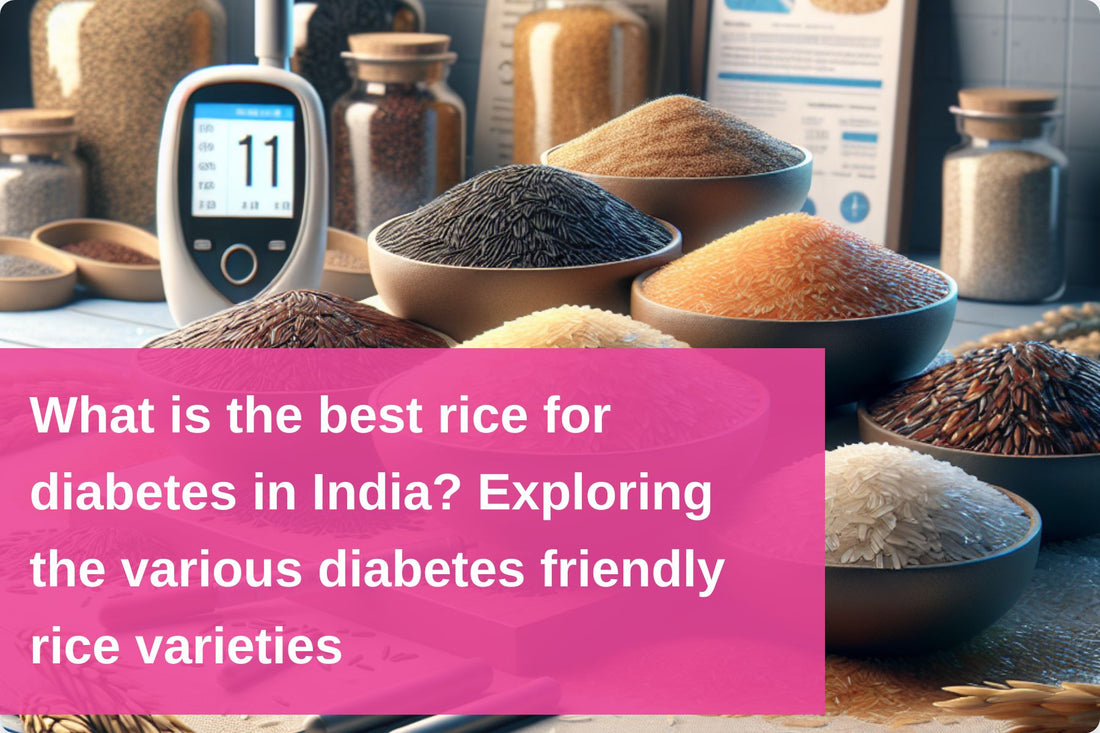In India, where rice is an important part of diet, understanding how it affects diabetes is crucial for those managing the condition. Choosing the right kind of rice can significantly impact blood sugar levels and overall health. In this conversation, we'll explore diabetes-friendly rice options, aiming to guide individuals toward the best choices.
Rice holds deep cultural significance in India, but not all rice is the same when it comes to diabetes. The idea of the "best diabetic rice in India" goes beyond a generic label; it's about finding varieties that align with nutritional needs and help maintain stable blood sugar levels.
As someone with diabetes, I know the importance of making informed choices about the foods I eat. It's not just about limiting yourself; it's about embracing alternatives that promote well-being. So, let's navigate through the diverse world of rice varieties, exploring which ones can be allies in managing diabetes.
Basmati Rice and Diabetes
1. Basmati Rice and Diabetes: Known for its lower glycemic index, beneficial for managing blood sugar levels.
2. Benefits for Blood Sugar Control: Slower increase in blood glucose after consumption compared to other rice types.
3. Nutritional Value: Rich in vitamins and minerals, supporting overall health.
4. Personal Perspective: Valued choice in diabetes management, balancing cultural significance with health benefits.
Diverse Varieties: Brown, Black, and Red Rice
When it comes to managing diabetes through dietary choices, exploring beyond the conventional white rice opens up a world of possibilities. Brown rice, black rice, and red rice emerge as compelling alternatives, each offering unique benefits that extend beyond mere carbohydrate content.
Brown rice, unpolished and retaining its bran layer, stands out for its higher fiber content. This fibre slows down the digestion process, preventing rapid spikes in blood sugar levels. For individuals with diabetes, this gradual release of glucose is a key factor in maintaining stability.
Black rice, often referred to as "forbidden rice," not only adds a delightful hue to our plates but also brings a wealth of antioxidants to the table. These antioxidants contribute to overall health and potentially aid in managing diabetes by reducing oxidative stress.
Red rice, with its distinct nutty flavour, is another excellent choice for those mindful of their blood sugar. Rich in fibre, vitamins, and minerals, red rice complements a diabetes-friendly diet by providing essential nutrients without compromising on taste.
Incorporating these diverse rice varieties into our meals goes beyond managing diabetes; it's a celebration of flavour and nutrition. As someone navigating the complexities of this condition, I've found that embracing this variety not only brings excitement to my plate but also positively impacts my overall well-being. The colours on our plates represent a spectrum of health benefits, making the journey of managing diabetes not just manageable but enjoyable.
Other Alternatives: Boiled, Puffed, and Flattened Rice
As we look at different rice options for people with diabetes, it's important to think about choices like cooked rice, puffed rice, and flattened rice. These kinds have special qualities that can affect how blood sugar levels are managed.
1. Cooked Rice:
Cooking rice lowers its glycemic index compared to regular white rice, offering a slower impact on blood sugar and promoting steadier and controlled responses.
2. Puffed Rice:
Puffed rice, a common snack option, should be consumed in moderation by individuals managing diabetes due to its higher glycemic index, which can lead to quicker spikes in blood sugar; pairing it with high-fiber foods can help mitigate its impact on blood sugar levels.
3. Flattened Rice (Poha):
Flattened rice (poha) is a flexible option in a diabetes-friendly diet, offering a lower glycemic index than some other rice types and providing steady energy without causing sudden changes in blood sugar levels.
4. Diabesmart’s Low GI Rice:
Specifically designed with a glycemic index of less than 55, this rice helps in lowering sugar spikes and supports weight management, making it an ideal choice for managing a diabetic diet effectively.
Exploring Specific Varieties: Indrayani and Jeera Rice
Delving into specific rice varieties, Indrayani rice and Jeera rice, provides insights into their impact on diabetes management. For individuals like us, navigating through these options requires a keen understanding of their nutritional composition and how they interact with our blood sugar levels.
Indrayani Rice:
1. Moderate Glycemic Index: Indrayani rice is known for its aromatic qualities and has a moderate glycemic index.
2. Slower Rise in Blood Sugar: It tends to cause a slower rise in blood sugar levels compared to certain other rice varieties.
3. Suitable for Diabetes-Conscious Diet: This makes Indrayani rice a suitable choice for individuals managing diabetes, offering both flavor and better blood sugar control.
Basmati Rice:
1. Long and Slender Grains: The grains of Basmati rice are long and slender, and they elongate further when cooked. This characteristic makes it a preferred choice for dishes like biryani and pilaf, where separate, fluffy grains are desired.
2. Low Glycemic Index: Basmati rice has a lower glycemic index (GI) compared to other types of rice, making it a better option for managing blood sugar levels. This can be particularly beneficial for people with diabetes or those looking to control their carbohydrate intake.
3. Nutrient-Rich: Basmati rice is a good source of essential nutrients such as B vitamins, magnesium, and phosphorus. Brown Basmati rice, in particular, retains more fiber and nutrients than its white counterpart, offering additional health benefits.
Personal Perspective:
1. Navigating Rice Choices: Understanding the nuances of specific rice varieties empowers individuals to make informed decisions about their diet.
2. Enjoying with Confidence: Whether choosing Indrayani rice for its fragrance or Jeera rice for its warmth, these options can be enjoyed with confidence, aligning with health objectives and personal preferences.
Consuming rice the right way
In conclusion, the exploration of rice varieties in the context of diabetes in India reveals a nuanced landscape where informed choices play a pivotal role. While there isn't a one-size-fits-all solution, certain varieties stand out as diabetes-friendly options.
Basmati rice offers better blood sugar control with its lower glycemic index. Brown, black, and red rice provide added fiber and antioxidants. Boiled and flattened rice have lower glycemic indexes, while puffed rice should be enjoyed in moderation due to its potential for quick blood sugar spikes.
Indrayani rice suits a diabetes-conscious diet with its moderate glycemic index, whereas Jeera rice requires portion control. Personalize choices based on individual health needs, emphasizing balance and moderation while enjoying the variety of rice in Indian cuisine.
DiabeSmart's Low GI Rice: The diabetic specialist rice that cooks and tastes like regular white rice. Clinically tested (GI < 55) to help manage blood sugar levels. Recommended by doctors and great for the whole family.
This Blog post is an initiative by DiabeSmart, to provide accurate and Nutritionist / Doctor approved information related to Diabetes. DiabeSmart is India's first Food brand designed specifically for Diabetics, that has been clinically tested on Diabetics and Pre-Diabetics to deliver 55% - 70% lower Sugar spikes. DiabeSmart is part of Lo! Foods - India's leading brand for Everyday Functional Health foods.











